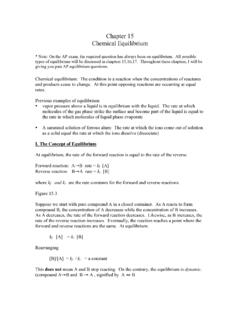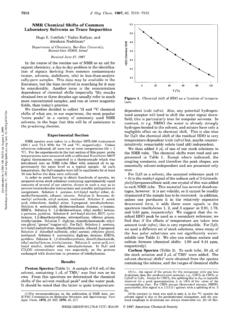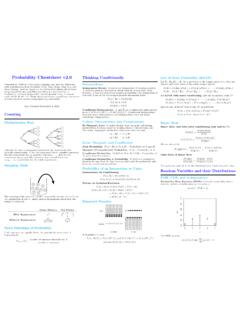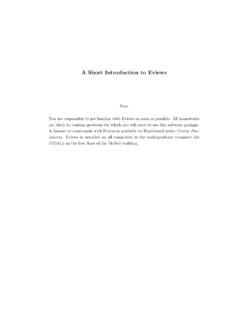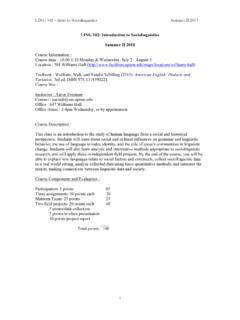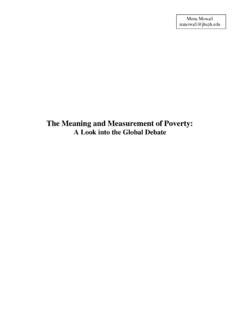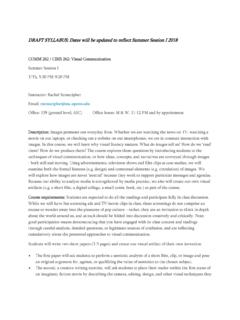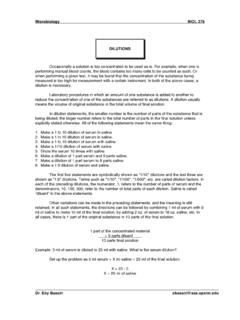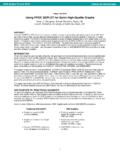Transcription of Microbiology BIOL 275 DILUTIONS
1 Microbiology BIOL 275. DILUTIONS . Occasionally a solution is too concentrated to be used as is. For example, when one is performing manual blood counts, the blood contains too many cells to be counted as such. Or when performing a given test, it may be found that the concentration of the substance being measured is too high for measurement with a certain instrument. In both of the above cases, a dilution is necessary. Laboratory procedures in which an amount of one substance is added to another to reduce the concentration of one of the substances are referred to as DILUTIONS . A dilution usually means the volume of original substance in the total volume of final solution. In dilution statements, the smaller number is the number of parts of the substance that is being diluted; the larger number refers to the total number of parts in the final solution unless explicitly stated otherwise.
2 All of the following statements mean the same thing: 1. Make a 1 to 10 dilution of serum in saline. 2. Make a 1 in 10 dilution of serum in saline. 3. Make a 1 to 10 dilution of serum with saline. 4. Make a 1/10 dilution of serum with saline. 5. Dilute the serum 10 times with saline 6. Make a dilution of 1 part serum and 9 parts saline. 7. Make a dilution of 1 part serum to 9 parts saline. 8. Make a 1:9 dilution of serum and saline. The first five statements are symbolically shown as "1/10" DILUTIONS and the last three are shown as "1:9" DILUTIONS . Terms such as "1/10", "1/100", "1/500", etc. are called dilution factors. In each of the preceding DILUTIONS , the numerator, 1, refers to the number of parts of serum and the denominators, 10, 100, 500, refer to the number of total parts of each dilution. Saline is called diluent in the above statements. Other variations can be made in the preceding statements, and the meaning is still retained.
3 In all such statements, the directions can be followed by combining 1 ml of serum with 9. ml of saline to make 10 ml of the final solution, by adding 2 oz. of serum to 18 oz. saline, etc. In all cases, there is 1 part of the original substance in 10 parts of the final solution. 1 part of the concentrated material + 9 parts diluent____. 10 parts final solution Example: 5 ml of serum is diluted to 25 ml with saline. What is the serum dilution? Set up the problem as 5 ml serum + X ml saline = 25 ml of the final solution. X = 25 - 5. X = 20 ml of saline Dr. Eby Bassiri Microbiology BIOL 275. The serum dilution is the amount of serum in the amount of total solution; hence, this is a 5/25 serum dilution which would equal a 1/5 dilution. Titer The titer is the smallest amount or concentration that will produce a particular effect or endpoint. Example: A series of solutions of serum in saline is prepared in the following DILUTIONS : 1/2, 1/4, 1/8, and 1/16.
4 A test for the presence of an antibody was made on each solution. It was positive for the 1/2 and 1/4 DILUTIONS but negative for the 1/8 and 1/16 DILUTIONS . The titer of the antibody is said to be 1/4. Series of DILUTIONS Two important points should be considered in DILUTIONS : how each dilution is made and what each dilution contains. The important consideration is the concentration of the materials in the dilution. However, it is first necessary to know how a dilution was made. A general rule to use in calculating the concentration of solutions in a series is to multiply the original concentration by the first dilution factor, this by the second dilution factor, this by the third dilution factor, and so on until the final concentration is known. Example: A 5M solution of HCl is diluted 1/5. The resulting solution is diluted 1/10. Determine the concentration of each of the solutions.
5 In this example, one solution is made from a solution that was yet made from another. To calculate the concentration of any of the solutions in such a series, first express all DILUTIONS as a fraction, then multiply the concentration of the beginning solution by the dilution factor used in each succeeding step. The following steps are used in solving this example. 1. The concentration of the first solution is given as 5M HCl. This then is the first answer. 2. The second solution was made by a 1/5 dilution of the first solution. The concentration of HCl in the second solution would be calculated by multiplying the concentration of the first solution by the dilution factor used to produce the second solution. Hence, the second solution has an HCl concentration of 1M. 5M HCl x 1/5 = 5M/5 =1M. 3. To calculate the concentration of HCl in the third solution in the series, multiply the original concentration of HCl by the value of each succeeding dilution factor.
6 5M x 1/5 x 1/10 = 5M/50 = 1M/10. Therefore, the concentration of HCl in the last solution is Notice that in each solution of this problem the concentration is expressed in molarity. This is because the concentration of the original solution was measured in molarity. In this type of problem the concentration of each dilution will be expressed in the same unit as that used in the original solution. The calculations used to determine the concentration of each solution in a series may be used in reverse to produce a dilution series having prescribed concentrations at each step. Dr. Eby Bassiri Microbiology BIOL 275. Example: Make the following DILUTIONS of serum in buffer: 1/10, 1/100, and 1/500. Before attempting to solve such a problem, it should be mentioned that any one dilution could usually be made by several procedures depending on how large a volume of the final solution is needed and how much of the original solution (to be diluted) is available.
7 For example, in the problem above, we may need only 10 ml of the 1/500 dilution, so if we take 1 ml of the original serum and add 499 ml of buffer, we will be left with a large volume of a solution, most of which is of no use to us. Additionally, storage space is a precious commodity to many research and health workers. Now back to solving our original problem. 1. To make the first dilution, place 1 part serum in a vessel and bring the total volume up to 10. parts total. This is a 1 to 10 dilution of serum in buffer. The "parts" can mean any multiple or fraction of any unit of measurement. For example, let 1 part equal 1 ml. This means that 1 ml of serum was brought up to 10 ml total with buffer. One could let 1 part equal ml, ml, 1. liter, etc., as long as all related calculations are based on the same thing. 2. To make the 1/100 serum in buffer dilution, use the first dilution as a starting point and repeat the procedure in step 1 above; , place 1 part of the 1/10 diluted serum in a vessel and bring the volume up to 10 parts total.
8 If a 1/10 dilution was not prepared ahead of time, one could make the 1/100 dilution directly, provided sufficient buffer was available. In this case, 1 part of the undiluted serum would need to be mixed with 99 parts of the buffer in the vessel. 3. To make the 1/500 dilution of serum in buffer, the easiest way is to make a 1/5 dilution of the 1/100 dilution that was already prepared; , bring 1 part of the 1/100 dilution of serum in buffer up to 5 parts total volume. Thus: 1/100 x 1/5 = 1/500. Serial DILUTIONS Many procedures call for a dilution series in which all DILUTIONS after the first one are the same. This type of dilution series is referred to as a serial dilution. This method and calculations discussed here are used in producing a series of solutions having equal increments of dilution. Note that "serial dilution" is a special case of "series of DILUTIONS ".
9 Example: A serum sample is diluted twice with buffer. A series of five DILUTIONS is made of this first dilution by diluting it 1/10, rediluting 1/10, and then three times more, each resulting solution then being a 1/10 dilution of the previous one in the series. The concentration of serum in each solution is as follows: 1/2, 1/20, 1/200, 1/2,000, 1/20,000, and 1/200,000. Example: The instructions indicate that a 1/10,000 dilution of a stock solution is to be made in water. This means 1 part of stock solution and 9,999 parts of water. If you equate 1 part as 1 ml, this would mean that we would end up with 10,000 ml (= 10 liters) of the diluted solution which is quite a large volume. Most probably, you may not have enough shelf space to store this amount. Furthermore, you may actually need only a few mls of the diluted solution. So we have to use some other way of doing the dilution without ending up with such surplus.
10 One quick, economical and efficient way is as follows: 1 ml stock/10 ml water x 1/10 x 1/10 x 1/10 = 1/10,000 dilution Dr. Eby Bassiri Microbiology BIOL 275. This means taking only 1 ml of the original stock and diluting it 1/10 four times. This would produce 10 ml of a 1/10,000 dilution of stock in water. Another way is to dilute the stock 1/10 twice and then perform a further 1/100 dilution: 1/10 x 1/10 x 1/100 = 1/10,000 dilution This would yield 100 ml of a 1/10,000 dilution of stock in water. Yet another way is to make a 1/100 dilution twice: 1/100 x 1/100 = 1/10,000 dilution This would produce 100 ml of a 1/10,000 dilution of stock in water. Any combination of DILUTIONS that will yield a final concentration of 1/10,000 may be used. As mentioned earlier, the combination is determined in part by the glassware available and the volume needed. Determining Volumes and Concentrations To decide what dilution to use, one needs to know several things: 1.
